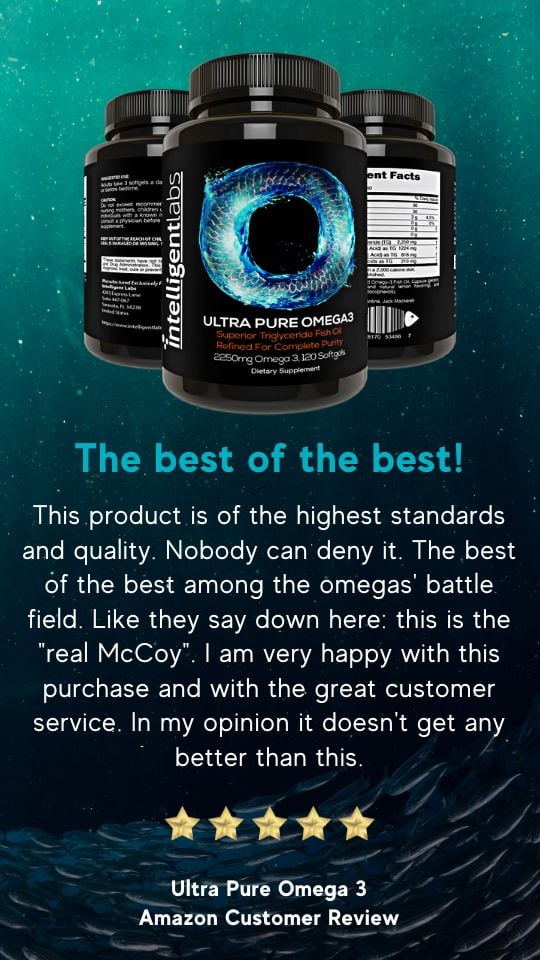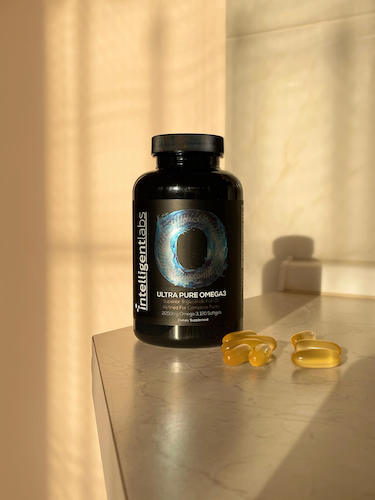Omega-3 fish oil comes in two types, natural triglycerides and ethyl esters. Knowing the differences between these two can help you choose the right Omega-3 Fish Oil supplement. The type of fish oil affects the amount of omega-3 that the stomach can absorb. Also, it matters how effective that omega-3 is once it’s actually in the body.
Table of Contents
What Are Omega-3 Triglycerides and Ethyl Esters?
To better understand the differences between these two types of fish oil, we’ll divide this section into two parts.
What are Omega-3 Triglycerides?
Triglycerides (TG) is the natural form of omega-3 in fish (1). They make up about 95% of fats in the diet. This is also how fats are normally stored in the body.
Omega-3 Triglycerides contain 3 fatty acids attached to a glycerol backbone. The two main omega-3 fatty acids are eicosapentaenoic acid (EPA) and docosahexaenoic acid (DHA), but there are other types, too. Get to know the different types of omega-3 fatty acids here.
What are Omega-3 Ethyl Esters?
Ethyl ester (EE) omega-3 is artificially created in a lab by breaking the bond between the fatty acids and their glycerol backbone. A single fatty acid is then attached to a molecule of ethanol (alcohol) in a process known as trans-esterification.
Trans-esterification concentrates the fish oil and removes impurities. Companies can only create high-strength EPA and DHA omega-3 supplements free from contaminants by using this process. Without concentrating the fish oil, it’s extremely difficult to get a proper dose of omega-3.
For example, a supplement like cod liver oil that’s not concentrated has a very low level of EPA and DHA. They also often cause stomach upset and other side effects due to their impurities (2).
3 Reasons To Buy Triglyceride Fish Oil (and NOT Ethyl Ester)
#1 – Triglyceride fish oil is the natural form
The first reason is that because Triglyceride fish oil is in its natural form, it has a much higher bioavailability than omega-3 ethyl esters (3, 4, 5). That means the body can utilize more of the EPA and DHA in triglyceride fish oil than from EE fish oil (6).

#2 – Triglyceride omega-3 is better absorbed and processed
EE fish oil is 10 to 50 times less efficiently processed by the body than triglyceride fish oil (7). This is because of the unnatural chemical formulation of EE’s which means they must be broken down differently by pancreatic lipase enzymes.
The enzymes must remove the ethanol bond from the fatty acid in the EE form of fish oil. And then attach it to other dietary glycerol to form a triglyceride before it can be properly absorbed.
The absorption happens in the cells lining the intestinal wall known as enterocytes. Once this process is completed, the omega-3 fatty acids can be transported through the lymph system on chylomicrons. Eventually, they will enter the bloodstream at the thoracic duct. The process is much more inefficient, less effective, and slower with EE fish oil than TG fish oil.
#3 – Triglyceride fish oil stays fresh longer than ethyl ester fish oil
The third reason is that EE fish oil oxidizes more quickly and easily than triglyceride fish oil. Oxidation is when a molecule breaks down chemically and becomes rancid (8, 9, 10, 11).
Polyunsaturated fatty acids, like fish oils, are particularly prone to oxidation because of their double bond structures. This is why fish oils always contain antioxidants, e.g. vitamin E tocopherols, to prevent oxidation from happening.
Related article: Omega-3: The Ultimate Supplement Guide
Why is Ethyl Ester Inferior Compared to Triglycerides Omega-3?
EE fish oil is technically fish oil concentrate rather than real fish oil. Legally, it can be called “fish oil” but it’s really semi-synthetic. Although both ethanol and fatty acids are natural substances, they are never found together in nature.

The trans-esterification process is necessary to make concentrated and pure fish oil. But the EE concentrate can be converted back to the natural triglyceride form as re-esterified fish oil!
Specialist enzymes remove the ethanol backbone, thus separating the fatty acids and ethanol. The next step is to remove ethanol. Then glycerol is reintroduced.
The enzymes reattach the fatty acids to the glycerol backbone, creating natural omega-3 triglycerides again! The re-esterified omega-3s are still completely pure. But this extra process means they’re now back in their natural form (TG). Plus, they also have much higher EPA and DHA concentrations, too!
However, the vast majority of fish oil manufacturers skip the last step above because it’s expensive and time-consuming. It adds around 40% to the raw material costs. Because of this, many omega-3 fish oils in the market are in the artificial EE form and not TG fish oil.
How Much Better Are Omega-3 Triglycerides Than Ethyl Esters?
One study showed that omega-3 in the triglyceride form has 71% greater absorption than EE’s (2).
Another study found that free fatty acids were 400% better absorbed than ethyl esters (12). Interestingly, the ethyl ester omega-3 supplement used in the study was Lovaza. The pharmaceutical giant GSK produces this product, and is only available on prescription. Unfortunately, this means that doctors are still prescribing the inferior EE omega-3 form of fish oils.
Omega-3 is one of the most researched substances in medical history. But much of the research has only tested EE fish oil’s benefits. Fortunately, more research confirming the advantages of triglyceride fish oil vs ethyl ester is coming to light.
For example, one 6-month study reported that triglyceride supplements had better bioavailability than EE supplements (13).
Another study reported that triglyceride omega-3 was significantly better at reducing circulating blood triglyceride levels than EE fish oil (14). Circulating triglyceride levels in the blood are a significant CV risk marker. It’s one of the criteria used to diagnose metabolic syndrome.
How Do I Know If My Omega-3 Supplement Is Triglyceride or Ethyl Ester?
Check your bottle of omega-3. If it doesn’t specifically say whether it’s ethyl ester or triglyceride, then it’s an ethyl ester. That’s because it’s so much more expensive to produce triglyceride fish oil. So, every company that uses triglyceride fish oil clearly advertises the fact on their bottles.
If you are still unsure, contact the company that makes your omega-3. Ask to see their 3rd party testing certificates; it will state there whether it’s EE or TG. There’s also a test you can perform at home. However, it does involve using 20ml or so of fish oil.
Here’s how to check if your fish oil is triglyceride or ethyl ester:
- Put 20 ml of fish oil in a polystyrene cup (20 ml is about 20 large capsules worth) and leave it for 10 minutes.
- After 10 minutes, if it’s an EE fish oil, it will have leaked through the cup.
- However, if it’s a triglyceride fish oil, it won’t leak (although the triglyceride fish oil may start to leak after 2-3 hours).





